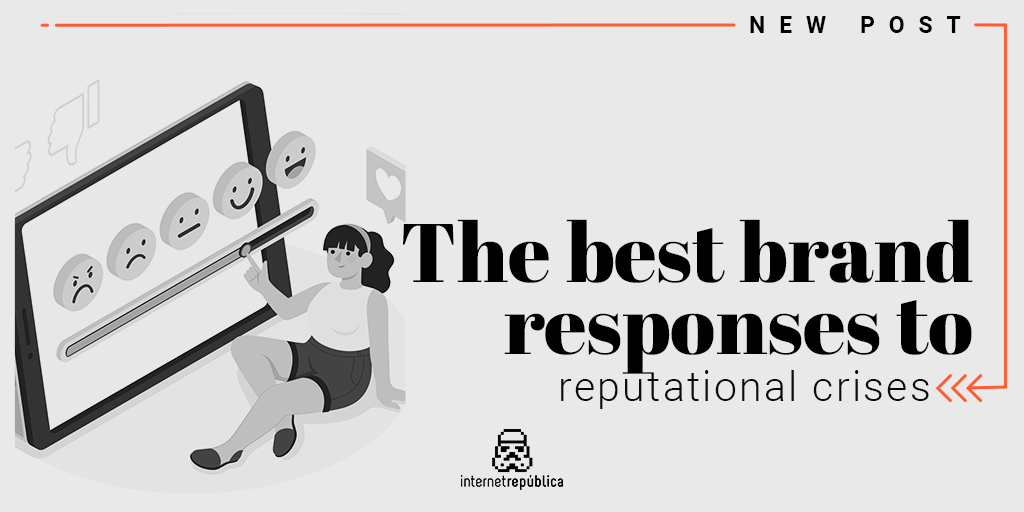
The best brand responses to reputational crises
A brand’s reputation is one of its most valuable assets. However, reputational crises can arise at any time and can have serious consequences for the brand if the right action is not taken.
What is a reputational crisis?
A reputational crisis is a situation in which a brand is negatively affected, usually by something the brand itself has done, and experiences a significant decrease in the positive perception of its public image. This is usually the result of different situations, such as a scandal, a defective product, poor public relations management or an inadequate response.
How to deal with a reputational crisis?
- Recognise the problem: the first step in resolving a reputational crisis is to recognise it, because ignoring it will only make the situation worse. You have to show your face.
- Transparent communication: you must give some kind of communication about the situation in an open and honest way about what is happening, the cause of it if necessary and how it is being managed.
- Taking responsibility: it is very important to take responsibility for the crisis (if it was the brand’s fault), face up to it and apologise sincerely.
- Corrective action: corrective action should be taken to address the problem at the outset and prevent it from happening again.
The best brand responses to reputational crisis
Boeing case
Boeing, a leading aircraft designer and manufacturer, received a letter from an 8-year-old boy showing a drawing of an aeroplane and how to design it to put out fires. The boy’s father, who loved aeroplanes, sent the letter and the drawing to the company and received an unusual reply that ignored the childish nature of the drawing and made it clear that they did not accept proposals “(…) experience had shown that their engineers had already considered most of the ideas that came to them” and that “the time, cost and risk of implementing them did not justify the benefits”. Following this response, the father shared it on his blog and it was echoed on social media.
How did Boeing respond?
The company’s own communications director acted as a spokesperson for the company via Twitter, posting several apologetic messages such as “We are experts in aeroplanes but beginners in social media. We are learning as we go”. In addition, they invited the little boy’s family to visit Boeing’s facilities to make amends for the initial lack of sensitivity.
Why is this an example of a well-managed crisis?
They were faced with the need to provide a clear response in the shortest possible time to this crisis, so they delegated reputational crisis experts to learn the gravity of the situation and acted in a sincere manner, apologising and taking responsibility.
Lufthansa case
In 2015, Germanwings, Lufthansa’s low-cost operator, suffered a major reputational crisis when one of its pilots caused an accident in the Alps that killed more than 150 people.
How did Lufthansa respond?
It posted several messages on its social media with detailed information about the accident, acknowledged that the event was the fault of one of its employees, took the side of the affected families, offered care services for the victims, covered the costs of the accident and as a sign of respect used the hashtag #indeepsorrow (with deep sorrow).
Why is this an example of a well-managed crisis?
In such a serious situation, the brand’s response is very important. It was honest at all times, doing the right thing, even if it called safety into question. Showing your face at a time like this is essential.
Donettes case
In 2011, the Donettes pastry brand launched an offline campaign that was intended to carry funny messages, but in this case it was unfortunate. The packaging read “to order, by the metre”, as a call for individual consumption of the product. A stir was started on social networks with the hashtag #boicotdonettes.
How did Donettes respond?
The brand’s managers responded on social networks, firstly by communicating that they were listening to the opinions and looking for a solution, and after this, they apologised and withdrew all the products with this slogan.
Why is this an example of a well-managed crisis?
The key to this management lies in the apology and the subsequent messages with which the situation was addressed, acknowledging the mistake and showing that they were listening to the public, without giving a hasty response.
Artículos relacionados
admin
Latest posts by admin (see all)
- Outbound or Inbound Marketing? - 28 September, 2023
- The best brand responses to reputational crises - 21 September, 2023






